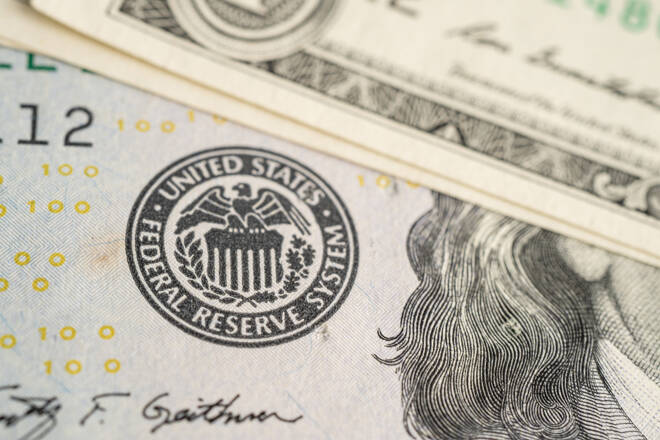Advertisement
Advertisement
DXY Primed For Best Week Since April 2020 Amid Fed Hawkishness, Global Growth Worries
By:
The Dollar Index surpassed 108.00 on Friday, nearing its annual highs, boosted amid a cocktail of bullish developments.
Key Points
- The DXY rallied above 108.00 on Friday and was on course for its strongest week since April 2020.
- Hawkish Fed commentary and concerns about growth in China/stagflation in Europe have boosted the safe-haven buck this week.
- GBP/USD fell back to within a whisker of annual lows under 1.1800.
DXY on Course For Strongest Week Since 2020 Pandemic Panic
The US Dollar Index (DXY), a trade-weighted basket of major USD forex pairs, was on course for its strongest week since the pandemic panic in April 2020. The DXY rallied another 0.6% on Friday to above 108.00, its highest level since 15 July and taking its weekly gains to 2.3%.
Analysts cited the hawkish tone of Fed policymakers this week as one major factor supporting the US dollar. Fed officials differed in their preferences as to how fast and high the central bank should lift rates in the coming quarters, but were unanimous in their commitment to prioritize bringing inflation down, which remains at levels that they deem to be far too high.
Analysts have also cited safe-haven demand amid growth fears in China and stagflation fears in Europe as the energy crisis there worsens as supporting the US dollar. As was the case in the 2020 pandemic panic, traders tend to flee to the US dollar in times of strife/concerns about the global economy, given its status as the global reserve currency.
Hawkish Shift in ECB Expectations Fails to Lift Euro
German Producer Price Inflation hit a new record high in July, data released on Friday showed, underscoring comments made by influential ECB policymaker Isabel Schnabel on Thursday, who at the time cautioned that the Eurozone inflation outlook has not improved since the central bank’s July meeting, comments which markets took as a hint that she will support another large rate hike next month.
Recent commentary from Schnabel and Friday’s German PPI surprise have seen markets up their ECB tightening bets, with Eurozone money markets now pricing in a 50 bps rate hike in September with certainty, and even implying a small chance of an even larger 75 bps hike. But this shift in expectations has failed to lift the euro, which depreciated a further 0.4% versus the buck on Friday.
That’s because the Eurozone economy looks to be on the brink of/already in stagflation, where inflation is rising as the economy shrinks. A more aggressive ECB tightening cycle adds to downside Eurozone economic risks, which is likely why markets are interpreting recent developments as a negative for the euro.
Sterling Set for Worst Week Since September 2020
GBP/USD depreciated a further 0.9% on Friday and came within a whisker of hitting fresh lows for the year after briefly dipping under 1.1800, as stagflation fears and data showing UK consumer sentiment hitting a record low in August negated stronger than expected UK Retail Sales in July. Sterling was on course for its biggest one-week drop aaginst the US dollar since September 2020, with GBP/USD last down over 2.5% on the week.
Aussie, Kiwi Worst Weekly Performs on Global Growth Woes
NZD/USD posted a sharp 1.2% drop on Friday, taking its weekly losses to over 4.0%, which would be its worst one-week performance since the Covid-19 pandemic spread globally in March 2020. Traders seem to have interpreted this week’s hawkish RBNZ meeting as adding to downside risks to the New Zealand economy at a time when the global growth outlook is suffering.
Indeed, Chinese data earlier this week showed a surprise slowdown in its economy in July and this has also weighed heavily on the Aussie. AUD/USD dropped a further 0.5% on Friday, taking its weekly losses to around 3.5%, which would mark its worst weekly performance in a year.
Elsewhere in the G10, a sharp rise in US bond yields across the curve pushed USD/JPY to fresh monthly highs in the 137.00 area, with the pair up 0.75% on the day and over 2.5% this week. USD/CAD, meanwhile, saw its losses cushioned on Friday cushioned by strength in oil prices and Canadian retail sales figures, with the pair rising another 0.3% and taking its weekly gains to about 1.7%. Nonetheless, at current levels just under 1.30, the pair is trading at its highest in a month.
About the Author
Joel Frankauthor
Joel Frank is an economics graduate from the University of Birmingham and has worked as a full-time financial market analyst since 2018. Joel specialises in the coverage of FX, equity, bond, commodity and crypto markets from both a fundamental and technical perspective.
Advertisement
